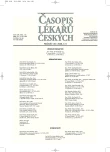Fatty Liver Disease and Statins – Which Discipline the Problem Belongs To?
Nemoc tučných jater a statiny – kterému oboru patří tento problém?
Nemoc tučných jater je sice dříve poznaná kategorie, ale dnes se objevuje ve zcela novém světle. Jde jednoznačně o mezioborový problém. Množství nemocných s nemocí tučných jater nebude zanedbatelné. Na problematiku nemoci tučných jater se nezřídka upozorňuje v souvislosti s léčbou statiny v rámci metabolického syndromu a preventivním omezením kardiovaskulárních rizik. Zcela neúměrná pozornost je pak upřena na zvyšování hladiny alanin aminotransferázy v průběhu této léčby. V práci je proveden přehled uvedené problematiky, ze které vyplývá, že indukovaný vzestup alanin aminotransferázy je pouhý průvodní jev, většinou bez jakékoli klinické významnosti. Přijatelný vzestup alanin aminotransferázy by neměl představovat důvod k vysazení statinů z obvyklého spektra nemocných s metabolickým syndromem a nemocí tučných jater. Výhodnou se zde jeví spolupráce zejména mezi hepatologem, kardiologem a diabetologem.
Klíčová slova:
nemoc tučných jater, statiny, alanin aminotransferáza, kardiovaskulární nemoci.
Authors:
J. Šochman
Authors‘ workplace:
Klinika kardiologie IKEM, Praha
Published in:
Čas. Lék. čes. 2006; 145: 443-446
Category:
Review Article
Overview
While fatty liver disease is a well-characterized entity, it is currently getting a completely new image. Its treatment is clearly an interdisciplinary challenge. The number of patients with fatty liver disease will be by no means negligible. The issue of fatty liver disease is not infrequently referred to in association with statin therapy instituted in an effort to treat metabolic syndrome and to reduce cardiovascular risks as part of preventive therapy. The attention focused on the increase in alanin aminotransferase levels during statin therapy is absolutely inadequate. The study includes an overview of the topic showing the induced rise in alanin aminotransferase is merely an accompanying phenomenon, mostly of no clinical relevance. An acceptable increase in alanin aminotransferase should not provide a reason for statin withdrawal in the usual spectrum of patients with metabolic syndrome and fatty liver disease. A distinct advantage is cooperation among a hepatologist, a cardiologist, and a diabetes expert.
Key words:
fatty liver disease, statin, alanin aminotransferase, cardiovascular disease.
Labels
Addictology Allergology and clinical immunology Angiology Audiology Clinical biochemistry Dermatology & STDs Paediatric gastroenterology Paediatric surgery Paediatric cardiology Paediatric neurology Paediatric ENT Paediatric psychiatry Paediatric rheumatology Diabetology Pharmacy Vascular surgery Pain management Dental HygienistArticle was published in
Journal of Czech Physicians

- Advances in the Treatment of Myasthenia Gravis on the Horizon
- Metamizole vs. Tramadol in Postoperative Analgesia
- Spasmolytic Effect of Metamizole
- Metamizole at a Glance and in Practice – Effective Non-Opioid Analgesic for All Ages
- Metamizole in perioperative treatment in children under 14 years – results of a questionnaire survey from practice
Most read in this issue
- Faecal Elastase I. Assessment – Its Use in Diagnosis of Chronic Pancreatitis
- Injury of the Scapholunate Interosseal Ligament – Scapholunate Dissociation
- Hyperamylasemia, Laboratory and Clinical Aspects
- Capsule Endoscopy – The Past, Presence, and Future
